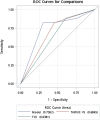Pre-hospital THRIVE score predicts the thrombolysis in cerebral infarction outcome post endovascular thrombectomy: an emergency medical service study
- PMID: 41023815
- PMCID: PMC12482229
- DOI: 10.1186/s12873-025-01352-3
Pre-hospital THRIVE score predicts the thrombolysis in cerebral infarction outcome post endovascular thrombectomy: an emergency medical service study
Abstract
Background: The Totaled Health Risks in Vascular Events (THRIVE) score, which ranges from 0 to 9, incorporates factors such as age, the National Institutes of Health Stroke Scale (NIHSS), and the presence of comorbidities including atrial fibrillation, diabetes mellitus, and hypertension. This study aimed to evaluate the predictive value of the THRIVE score on immediate revascularization status following endovascular thrombectomy (IAT).
Methods: This retrospective cohort study utilized data from the ASSST dataset, covering the period from January 1, 2017, to May 31, 2022. Patients with acute ischemic stroke who underwent IAT were included in this analysis. The association between the THRIVE score and recanalization status-assessed using the Thrombosis in Cerebral Ischemia (TICI) scale (grades 2b/3)-was evaluated employing logistic regression models.
Results: A total of 485 participants who received IAT were included in the analysis. Our findings revealed that a lower THRIVE score (OR 1.15, 95% CI 1.01-1.30), male sex (OR 1.81, 95% CI 1.15-2.87), and IAT performed following intravenous thrombolysis (OR 1.72, 95% CI 1.08-2.74) were significantly associated with successful revascularization. Youden's index identified a THRIVE score threshold of < 5 as optimal for predicting outcomes. Patients with a THRIVE score < 5 exhibited a higher likelihood of successful revascularization (OR 1.82, 95% CI 1.10-3.03).
Conclusion: A lower THRIVE score (< 5) is associated with an increased likelihood of successful revascularization following IAT in patients with acute ischemic stroke, particularly among women.
Keywords: Acute ischemic stroke; Recanalization; THRIVE score; Thrombectomy.
© 2025. The Author(s).
Conflict of interest statement
Declarations. Ethics approval and consent to participate: This study was approved by the Joint Institutional Review Board (IRB) of Taipei Medical University (IRB numbers: N202110064). Informed consent was waived by the IRB due to the use of anonymous and deidentified data. In accordance with the Declaration of Helsinki. Consent for publication: Not applicable. Competing interests: The authors declare no competing interests.
Figures




References
-
- Feigin VL, Stark BA, Johnson CO, Roth GA, Bisignano C, Abady GG, Abbasifard M, Abbasi-Kangevari M, Abd-Allah F, Abedi V. Global, regional, and national burden of stroke and its risk factors, 1990–2019: a systematic analysis for the global burden of disease study 2019. Lancet Neurol. 2021;20(10):795–820. - PMC - PubMed
-
- Katan M, Luft A. Global burden of stroke. Seminars in neurology: 2018. Thieme Medical; 2018. pp. 208–11. - PubMed
-
- Albers GW, Olivot J-M. Intravenous Alteplase for ischaemic stroke. Lancet. 2007;369(9558):249–50. - PubMed
-
- Jauch EC, Saver JL, Adams HP Jr, Bruno A, Connors J, Demaerschalk BM, Khatri P, McMullan PW Jr, Qureshi AI, Rosenfield K. Guidelines for the early management of patients with acute ischemic stroke: a guideline for healthcare professionals from the American heart association/american stroke association. Stroke. 2013;44(3):870–947. - PubMed
MeSH terms
LinkOut - more resources
Full Text Sources
Medical

